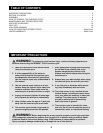
12
Exercise has proven essential for good health and
well-being. Regular participation in a well-rounded
exercise program results in a stronger and more effi-
cient heart, improved respiratory function, increased
stamina, better weight management, increased ability
to deal with stress, and greater self-esteem.
EXERCISE INTENSITY
To maximize the benefits of exercising, it is important
to exercise with the proper intensity. The proper inten-
sity level can be found by using your heart rate as a
guide. For effective aerobic exercise, your heart rate
should be maintained at a level between 70% and
85% of your maximum heart rate as you exercise.
This is known as your training zone. You can find
your training zone in the table below. Training zones
are listed according to age and physical condition.
During the first few months of your exercise program,
keep your heart rate near the low end of your training
zone as you exercise. After a few months of regular
exercise, your heart rate can be increased until it is
near the middle of your training zone as you exercise.
To measure your heart rate, use the built-in pulse
sensor. You can also measure your heart rate by plac-
ing two fingers on your wrist as shown. Stop exercis-
ing and take a six-
second heartbeat
count. Multiply the
result by ten to find
your heart rate. (A
six-second count is
used because your
heart rate drops
quickly when you
stop exercising.) If
your heart rate is too high, decrease the intensity of
your exercise. If your heart rate is too low, increase
the intensity of your exercise.
WORKOUT GUIDELINES
A well-rounded workout includes three important parts:
A warm-up, consisting of 5 to 10 minutes of stretching
and light exercise. A proper warm-up increases your
body temperature, heart rate, and circulation in prepa-
ration for exercise.
Training zone exercise, consisting of 20 to 40 min-
utes of exercising with your heart rate in your training
zone. (During the first few weeks of your exercise pro-
gram, do not keep your heart rate in your training
zone for longer than 20 minutes.)
A cool-down, with 5 to 10 minutes of stretching. This
will increase the flexibility of your muscles and will
help to prevent post-exercise problems.
EXERCISE FREQUENCY
To maintain or improve your condition, plan three work-
outs each week, with at least one day of rest between
workouts. After a few months of regular exercise, you
may complete up to five workouts each week, if
desired. CAUTION: Be sure to progress at your own
pace and avoid overdoing it. Incorrect or excessive
training may result in injury to your health.
Remember, the key to success is make exercise a
regular and enjoyable part of your everyday life.
WARNING: Before beginning
this or any exercise program, consult your
physician. This is especially important for
individuals over the age of 35 or individuals
withpre-existing health problems.
The pulse sensor is not a medical device.
Various factors may affect the accuracy of
heart rate readings. The pulse sensor is
intended only as an exercise aid in determin-
ing heart rate trends in general.
EXERCISE GUIDELINES


















